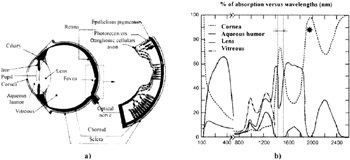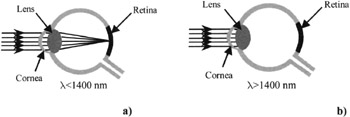3 Eye safety
3 Eye safety
The effects of the optical energy of a collimated beam laser are very different from the same optical energy transmitted by other light sources and this is due to its concentration, coherence , collimation and divergence properties. As for all illuminated surfaces, the biological tissues receive a high power density. The main phenomenon caused by the laser light is caused by high light density absorption .
Absorption happens between atomic or molecular energy levels and is a process dependent on wavelength. Hence, it is wavelength that determines the tissue that laser can damage. Figure 16.2 gives the range and designation of different wavelength bands of the electromagnetic spectrum.

Figure 16.2: The electromagnetic spectrum, from the UVC to the IRC
Some biological tissues of the skin, the eye lens and more precisely the retina can show non-reversible modifications caused by long time exposure to moderate light levels. These changes are the result of photochemical reactions which occur after molecule activation by photon capture. They can be drastic if the time of exposure is too long or if the exposures are repeated over a long period.
The eye, in Figure 16.3a, is an optical instrument which receives and focuses the light beams on the retina. The importance of the injuries and damages depend on the transmission and absorption characteristics of the tissues as well as the capacities to recover and regenerate from the lesions. We must emphasise that the fovea is the most important area of the retina since it senses the images for the clearest vision.

Figure 16.3: a) Transversal view of human eye and b) spectral absorption of different human media taken separately in human being [Sliney, 1980]
According to the International Electrotechnical Commission (IEC), 1550 nm wavelength is part of IRB. Pathologies associated with this spectral band are:
-
On the ocular level: inflammation of aqueous humor, cataract and cornea burn.
-
On the skin level: burns.
The grades relative to safety laser products are given by standards [CEI 825 “1, 2000] and [CEI 825 “1 /A11, 2000].
For infrared beams in the B band, either the aqueous humor absorbs more than the cornea, or the cornea aborption is widely dominating (from 70% to 100%, in function of wavelength, as indicated by * in Figure 16.3b). In Figure 16.4a, the light is focused on the retina whereas, in Figure 16.4b, light is absorbed by the cornea and by the lens. A retina burn can involve partial or total loss of vision, temporarily or in a definitive way. A lesion of the lens leads to cataract.

Figure 16.4: Characteristics of absorption and transmission of light in human eye: a) in visible and in the IRA, b) in the IR B and C, so that the UVB
Laser transmitters of UVC and far IRC radiation are dangerous for the cornea while visible and near infrared radiation are transmitted to the retina, the cornea protecting the lens against exposures superior to 4 W/cm 2 [Pitts, 1980].
Lasers which can operate in free propagation without danger for users' eyes, must hence transmit in the spectral bands in which the absorption is very weak. The most appropriate spectral region lies around 1552 nm since it is covered by many commercially available optical products (fiber optics technology); the possibility of establishing direct link between a local network and cornea light absorption looks low enough in its region.
At 1550 nm, the first ocular media crossed by light beam is the cornea, the absorption being not maximal (75%); it is spread over its entire thickness . We can note that if absorption was of 100% (that is, for a wavelength of 2 nm or upper than 2.5 nm), the aborption length would be weaker and therefore the dissipated energy per unit of volume would be more important, hence leading to more important damage. Power transmitted to aqueous humor is therefore weak and its absorption of 25% has little influence. The cornea has a resistance to radiation that is equal to the skin resistance and can regenerate itself very quickly. In an extreme case, a cornea graft can still be possible.
The Maximum Permitted Exposure levels a 1550 nm on a subject taken from references [CEI 825 “1, 2000] and [CEI 825 “1/A11, 2000] are:
-
1000 W.m ˆ’ 2 at cornea level.
-
From 100 W.m ˆ’ 2 to 1000 W.m ˆ’ 2 at skin level, MPE vary inversely for the surface exposed, from 0.1 m 2 to 0.01 m 2 respectively. For a larger surface, greater than 0.1 m 2 , the limit 100 W.m ˆ’ 2 applies.
A transmitter can be considered to be accessible under maximum security conditions when its light output power does not exceed 10 mW. It is then considered a "class I" light source. Its radiometric characteristics and measurement conditions are:
-
a 50 mm aperture diameter,
-
a radiation pattern inside a 0.01 steradian solid angle,
-
at a distance of 100 mm.
The calculated values given above are given for specific conditions:
-
time of exposure greater than 10 s,
-
observation aligned with the source axis.
We can conclude this normative overview by giving a definition of Nominal Ocular Hazard Distance (NOHD) , in which illumination or energy exposure and MPE are equal on the cornea level. Beyond this distance, the risk is nil.
In conclusion NF EN 60825 “7, June 2000 (1 st version), rewritten by European Committee of Electrotechnical Normalisation (CENELEC) about CEI 825 “7 reference of IEC purposes sources of wavelengths greater than 780 nm (IR) used in free space data transmissions. This document specifies higher elements given by references [CEI 825 “1, 2000; CEI 825 “1 /A11, 2000] and gives more details about essential limit values from which we establish one INDEED system specification.
EAN: 2147483647
Pages: 191